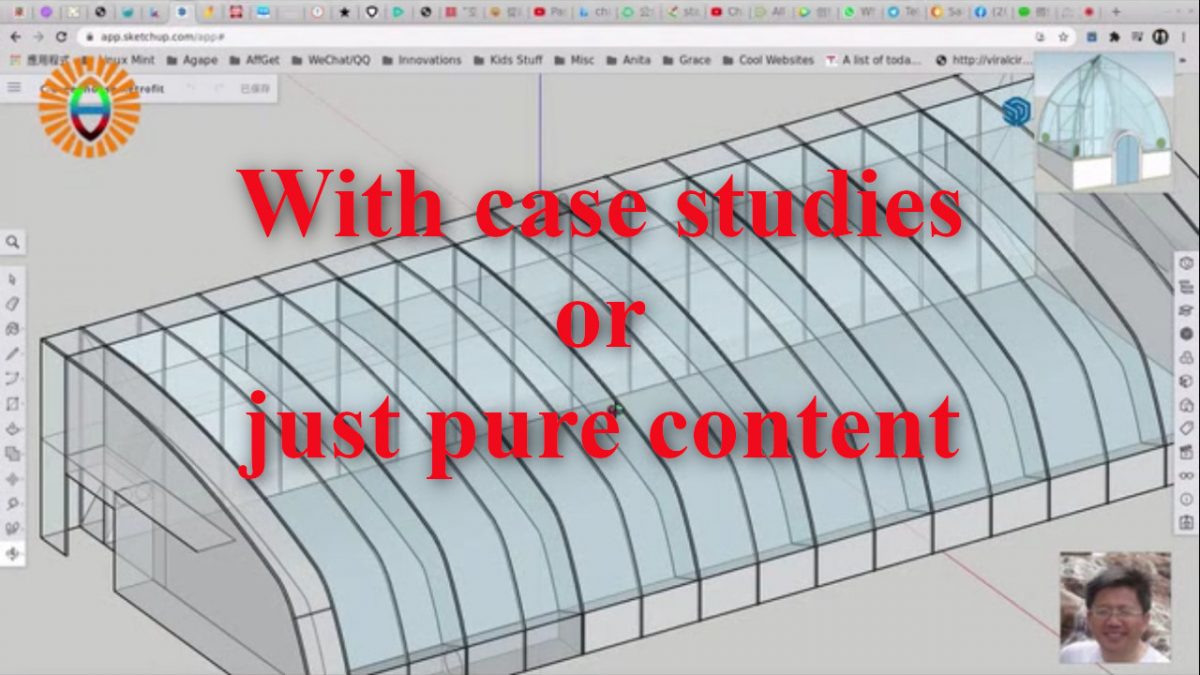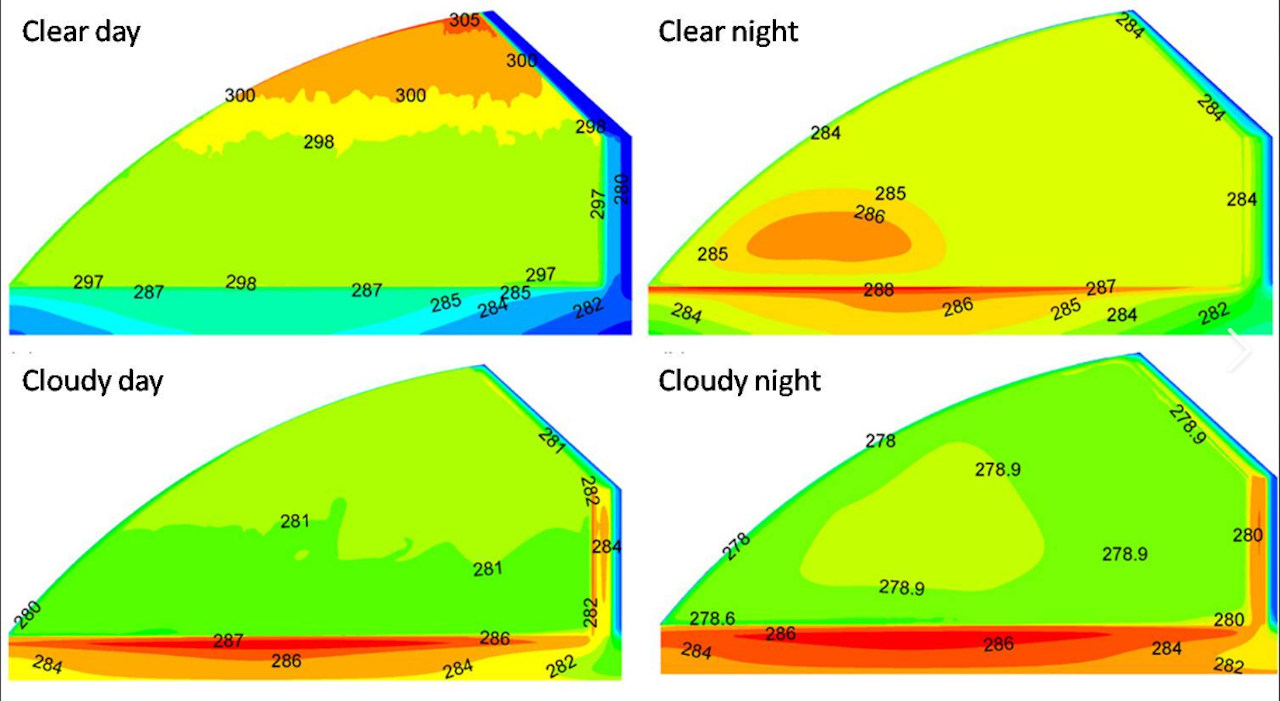In the following video, we compare the performance results between the traditional Chinese style passive solar greenhouse and the SolaRoof greenhouse. Critical issues have surfaced this way. After digging out the problems, we show a way to retrofit using the existing framework. A wonderful DIY project for you to start fresh or convert your existing greenhouse, to fully utilizing the wonderful properties of soap liquid bubbles.
Want to watch the version without comparison studies? See below…
The folloiwng infrared imaging profiles of the Chinese style passive solar greenhouse (click for source) indicate why it is not much of use in making the North wall opague and pack-filling it with dirt, a practice that most people have been taught to do so without understanding the issue clearly:
For those who would like to study Mr Jianyi Dong’s greenhouse that I mentioned above in the video, please click here.
Now you know everything about the difference!



8 replies on “Must View: The Critical Issues with Conventional Chinese Style Passive Solar Greenhouses Revealed – How to Solve with an Easy Retrofit Plan”
Aubrey –
Thanks for sharing Richard\’s bubble insulation SolaRoof design. I found your site when searching for more information on Dong Jianyi\’s greenhouse after seeing the webinar video you reference.
For more persistent bubbles (longer interval between bubble generating cycles) you might consider adding J-Lube, a veterinary obstetric lubricant. On his YouTube channel, the \”Honey Do Carpenter\” discusses adding this to shampoo based foam to make a more persistent foam for mixing foamed concrete.
Also, the thermal modelling results you show for the Chinese greenhouse seems to use a relatively low mass north wall compared to some I have seen in pictures (meters thick earthen wall). Especially at high latitudes, I suspect that a (nearly) vertical absorber (whether active or passive) is beneficial in mid-winter, and if it is an active absorber, it could better control temperature spikes at mid-day. I don\’t think the north wall needs to be an either/or proposition, though. It can be both a good absorber and be well insulated. I am at 47 degrees north latitude, but that is still well south of Jianyi, but much farther north than most of China and a good bit of Mongolia, if I am not mistaken. We also average in excess of 200\” of snow per winter, and have had as much as 360\” in a season, so snow load design is an important consideration for me.
An active absorber system can also be fabricated quite inexpensively, for example, here:
https://www.builditsolar.com/Experimental/MTD/MTD%20RH&JC.pdf
It might be possible to use the same pump system as for the foam nozzles to circulate through the absorber panels, though the requisite pressures and flow rates might not be a good match between the two systems. However, both systems should be able to share the same water mix, I think. Circulating warm water through the soil on cool night could also be beneficial for the plants.
Thanks again. You\’ve given me much food for thought.
Kevin
Kevin, thank you for your comment and concern!
In our case, persistence of bubbles is not the major issue, as long as you have bubble foam insulating the double layer cavity in winter and liquid film inside the cavity for cooling, you are roughly on the right track. The north wall issue, take a look at this IR imaging first, then you will know it is not that critical either – finding the critical and determinating factors is critical:
That is why in our design of my backyard build of PyraPOD, we came up a simpler approach to the geo thermal gain: we create a underground poopl filled with gravels and water. As simple as that!
Hi Aubrey. I’m near Hamilton, ON.
I’m interested in a building a 60,000 ft2 Chinese-style greenhouse. I’m intrigued by the bubbles. I have three questions:
How can I find out more about the bubble producing machines? What do you do with the moisture from all the bubbles that pop?
Doesn’t the pool make conditions in the greenhouse too humid?
Thank you so much for sharing.
Sorry Herman for replying late. For some reason, I just saw your comment now. I will answer your questions in reverse order…
Humidity and moisture not a problem at all as all the bubbles and water films are INSIDE a CLOSED double layer cavity, everything is contained. When the bubbles break up, the soap liquid flow back into the soap reservior which normally gets buried in the ground so that you have the geo thermal effect and creases the capacity for solar heat storage.
As for bubble generators, take a look at this video in which Richard Nelson explained how it works:
https://www.youtube.com/watch?v=fP8OsvUHbqE
I’ve made a few similar bubble machines myself, here is one video showing how I did it:
https://www.youtube.com/watch?v=VbZkXwgU5nA
In our recent designs, we have decided to place the bubble machines down on the ground and outside of the double-layer cavity. Take a look at this video:
https://www.youtube.com/watch?v=NksHdP36iOo
Hi,
Thank you for all the information. I first enountered Solaroof about 10 years ago, and I studied all the material I could find.
I have become interested in Chinese style solar greenhouses this past year, and I am considering building one here on my farm in Northern Vermont, near the Canadian border.
I don’t see many working examples of larger (3,000 s.f. +) greenhouses using this technology. Are there any working commercial models that you can refer me to?
Scott, thank you for the asking.
The short answer is, no, as I am the first one who have joined and started to commercialize the technology. There may be a few DIY projects in North America but I do not see anyone sharing about. I tried to contact Ross and Kat Elliot in Ontario and left message twice, they have never called back.
The next of our large design (new version of CityPOD) is roughly 50,000 SQF. I am in the process of buying a 108 acre farm land to set it up there. Will let you know when that happens.
what is the saop bubble solution and what is the decay time of the foam
i would like to experiment with this
thank you kindly
Nothing special when you are testing. Just any dish soap is fine. We do know dish soap may decompose with time, especially under the sun. But for testing and experiment, it is OK to work with dish soap.